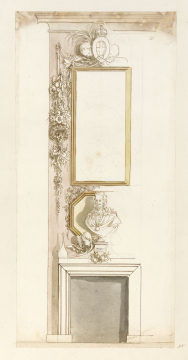
Browse
Reference number
Purpose
Aspect
Scale
Inscribed
Signed and dated
- Undated, but within range 1689-94
Medium and dimensions
Hand
Watermark
Notes
Gibbons’s sketch of the bust is consistent with several the details of Van Dyck’s triple portrait. This depicts Charles with a similar laced collar and buttoned vest, and with an oval garter medallion suspended from a garter ribbon. However, there exists at Arundel House another bust of Charles I based on Van Dyck’s triple portrait carved by the French sculptor Francois Dieussart in 1636, and Gibbons’s sketch may equally be a version of this example. The special prominence of the bust in the design is underscored by the octagonal framed backing panel (perhaps for a mirror).
The sketched portrait of Charles I in the large oval frame in the overmantel precedes the present drawing (the graphite is concealed by the yellow-green wash), and may have been abandoned when Gibbons decided to design the chimney-piece around an existing carved bust.
Literature
Level
Exhibition history
Sir John Soane's collection includes some 30,000 architectural, design and topographical drawings which is a very important resource for scholars worldwide. His was the first architect’s collection to attempt to preserve the best in design for the architectural profession in the future, and it did so by assembling as exemplars surviving drawings by great Renaissance masters and by the leading architects in Britain in the 17th and 18th centuries and his near contemporaries such as Sir William Chambers, Robert Adam and George Dance the Younger. These drawings sit side by side with 9,000 drawings in Soane’s own hand or those of the pupils in his office, covering his early work as a student, his time in Italy and the drawings produced in the course of his architectural practice from 1780 until the 1830s.
Browse (via the vertical menu to the left) and search results for Drawings include a mixture of Concise catalogue records – drawn from an outline list of the collection – and fuller records where drawings have been catalogued in more detail (an ongoing process).

